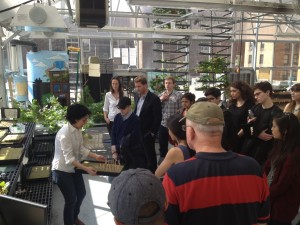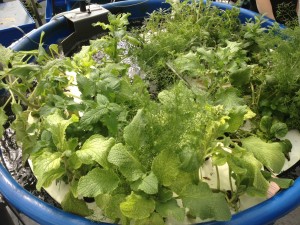June 6, 2013
Our tour of
The Greenhouse Project, lead by Manuela Zamora, Director of Education Programs and Sidsel Robards, Director of Program Development and Events, provided an exciting look at how New York City public schools are educating our children about science and the environment through hands-on laboratory experience.

Science is taught through the lens of urban farming, focusing on biology, chemistry, physics, earth science, and the living environment. Students engage in choosing growth media; selecting and planting seeds; combining plant-nutrients and water; monitoring plant growth; harvesting; monitoring NFT systems, VIG systems, vine crop systems, fish growth, and the fish farm; composting; controlling pests; measuring captured rainwater; predicting the weather; and more.
The Sun Works Center greenhouse at P.S. 333 will be the first rooftop environmental science lab among New York City public schools. It will provide a year-round space to teach kids about environmental sciences, climate change, conservation, food production, health and nutrition, and sustainable development. Given the success of The Greenhouse Project, 14 new greenhouses are being introduced into New York City.

The greenhouse is comprised of solar panels, a hydroponics growing system, a composting station, a rainwater catchment system, a weather station and an aquaponics system. This greenhouse is projected to grow 8,000 pounds of produce per year, including cucumbers, strawberries, lettuce, tomatoes, peppers, eggplants and squash. The harvest will be used for classroom snacks, cafeteria food, after school programs and more. Worms in the composting station will decompose leftover lunch scraps.

Two raised soil beds will teach younger students about how plants such as carrots, chives, celery and beans are traditionally grown. As many as 400-600 plants can be grown at any given time. Because pesticides are not used anywhere in the greenhouse, ladybugs will protect plants from pests such as aphids. In the aquaponics system, Tilapia will yield food and fertilizer for plants. About 40,000 gallons of rainwater are collected and filtered per year for cooling and irrigation.
Thank you to Ms. Zamora and Ms. Robards for leading this tour of the Sun Works Center greenhouse and demonstrating how students can get their hands dirty in the science of sustainability.
 Science is taught through the lens of urban farming, focusing on biology, chemistry, physics, earth science, and the living environment. Students engage in choosing growth media; selecting and planting seeds; combining plant-nutrients and water; monitoring plant growth; harvesting; monitoring NFT systems, VIG systems, vine crop systems, fish growth, and the fish farm; composting; controlling pests; measuring captured rainwater; predicting the weather; and more.
The Sun Works Center greenhouse at P.S. 333 will be the first rooftop environmental science lab among New York City public schools. It will provide a year-round space to teach kids about environmental sciences, climate change, conservation, food production, health and nutrition, and sustainable development. Given the success of The Greenhouse Project, 14 new greenhouses are being introduced into New York City.
Science is taught through the lens of urban farming, focusing on biology, chemistry, physics, earth science, and the living environment. Students engage in choosing growth media; selecting and planting seeds; combining plant-nutrients and water; monitoring plant growth; harvesting; monitoring NFT systems, VIG systems, vine crop systems, fish growth, and the fish farm; composting; controlling pests; measuring captured rainwater; predicting the weather; and more.
The Sun Works Center greenhouse at P.S. 333 will be the first rooftop environmental science lab among New York City public schools. It will provide a year-round space to teach kids about environmental sciences, climate change, conservation, food production, health and nutrition, and sustainable development. Given the success of The Greenhouse Project, 14 new greenhouses are being introduced into New York City.
 The greenhouse is comprised of solar panels, a hydroponics growing system, a composting station, a rainwater catchment system, a weather station and an aquaponics system. This greenhouse is projected to grow 8,000 pounds of produce per year, including cucumbers, strawberries, lettuce, tomatoes, peppers, eggplants and squash. The harvest will be used for classroom snacks, cafeteria food, after school programs and more. Worms in the composting station will decompose leftover lunch scraps.
The greenhouse is comprised of solar panels, a hydroponics growing system, a composting station, a rainwater catchment system, a weather station and an aquaponics system. This greenhouse is projected to grow 8,000 pounds of produce per year, including cucumbers, strawberries, lettuce, tomatoes, peppers, eggplants and squash. The harvest will be used for classroom snacks, cafeteria food, after school programs and more. Worms in the composting station will decompose leftover lunch scraps.
 Two raised soil beds will teach younger students about how plants such as carrots, chives, celery and beans are traditionally grown. As many as 400-600 plants can be grown at any given time. Because pesticides are not used anywhere in the greenhouse, ladybugs will protect plants from pests such as aphids. In the aquaponics system, Tilapia will yield food and fertilizer for plants. About 40,000 gallons of rainwater are collected and filtered per year for cooling and irrigation.
Thank you to Ms. Zamora and Ms. Robards for leading this tour of the Sun Works Center greenhouse and demonstrating how students can get their hands dirty in the science of sustainability.
Two raised soil beds will teach younger students about how plants such as carrots, chives, celery and beans are traditionally grown. As many as 400-600 plants can be grown at any given time. Because pesticides are not used anywhere in the greenhouse, ladybugs will protect plants from pests such as aphids. In the aquaponics system, Tilapia will yield food and fertilizer for plants. About 40,000 gallons of rainwater are collected and filtered per year for cooling and irrigation.
Thank you to Ms. Zamora and Ms. Robards for leading this tour of the Sun Works Center greenhouse and demonstrating how students can get their hands dirty in the science of sustainability.
